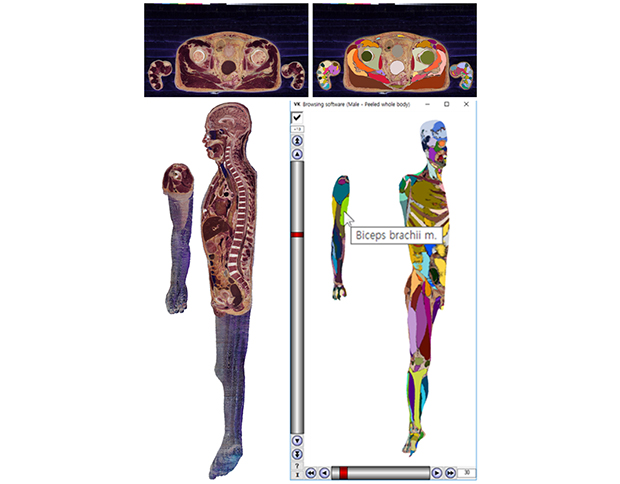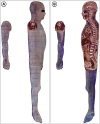1. Donnelly L, Patten D, White P, Finn G. Virtual human dissector as a learning tool for studying cross-sectional anatomy. Med Teach. 2009; 31(6):553–555.


2. Oh CS, Kim JY, Choe YH. Learning of cross-sectional anatomy using clay models. Anat Sci Educ. 2009; 2(4):156–159.


3. Shin DS, Chung MS, Park HS, Park JS, Hwang SB. Browsing software of the Visible Korean data used for teaching sectional anatomy. Anat Sci Educ. 2011; 4(6):327–332.


4. de Barros N, Rodrigues CJ, Rodrigues AJ Jr, de Negri Germano MA, Cerri GG. The value of teaching sectional anatomy to improve CT scan interpretation. Clin Anat. 2001; 14(1):36–41.


6. Kwon K, Shin HK, Shin BS, Park JS. Serially peeled images of the curved surface of the face based on cross-sectional images for use in plastic surgery. J Plast Reconstr Aesthet Surg. 2016; 69(5):727–729.

8. Chung BS, Kwon K, Shin BS, Chung MS. Peeled and piled volume models of the stomach made from a cadaver's sectioned images. Int J Morphol. 2016; 34(3):939–944.

9. Shin DS, Chung MS, Shin BS, Kwon K. Laparoscopic and endoscopic exploration of the ascending colon wall based on a cadaver sectioned images. Anat Sci Int. 2014; 89(1):21–27.


10. Chung BS, Kwon K, Shin BS, Chung MS. Surface models and gradually peeled volume model to explore hand structures. Ann Anat. 2017; 211:202–206.


11. Park JS, Chung MS, Hwang SB, Lee YS, Har DH, Park HS. Visible Korean human: improved serially sectioned images of the entire body. IEEE Trans Med Imaging. 2005; 24(3):352–360.

12. Shin DS, Park JS, Park HS, Hwang SB, Chung MS. Outlining of the detailed structures in sectioned images from Visible Korean. Surg Radiol Anat. 2012; 34(3):235–247.


13. Kwon K, Chung MS, Park JS, Shin BS, Chung BS. Improved software to browse the serial medical images for learning. J Korean Med Sci. 2017; 32(7):1195–1201.

15. Campbell J. Injections. Prof Nurse. 1995; 10(7):455–458.

16. Kotzé SH, Mole CG, Greyling LM. The translucent cadaver: an evaluation of the use of full body digital X-ray images and drawings in surface anatomy education. Anat Sci Educ. 2012; 5(5):287–294.


17. Bergman EM, Sieben JM, Smailbegovic I, de Bruin AB, Scherpbier AJ, van der Vleuten CP. Constructive, collaborative, contextual, and self-directed learning in surface anatomy education. Anat Sci Educ. 2013; 6(2):114–124.


20. Choi JY, Jang KS, Choi SH, Hong MS. Validity and reliability of a clinical performance examination using standardized patients. J Korean Acad Nurs. 2008; 38(1):83–91.

21. Yoo HH, Song CH, Han EH, Kim HT. The effect of education program of cadaver dissection for the paramedical students. Korean J Phys Anthropol. 2014; 27(3):145–154.

22. Smith SR, Lovejoy JC, Greenway F, Ryan D, deJonge L, de la Bretonne J, et al. Contributions of total body fat, abdominal subcutaneous adipose tissue compartments, and visceral adipose tissue to the metabolic complications of obesity. Metabolism. 2001; 50(4):425–435.


23. Färber M, Hummel F, Gerloff C, Handels H. Virtual reality simulator for the training of lumbar punctures. Methods Inf Med. 2009; 48(5):493–501.


24. Zankl M, Wittmann A. The adult male voxel model “Golem” segmented from whole-body CT patient data. Radiat Environ Biophys. 2001; 40(2):153–162.


25. Shin DS, Jang HG, Hwang SB, Har DH, Moon YL, Chung MS. Two-dimensional sectioned images and three-dimensional surface models for learning the anatomy of the female pelvis. Anat Sci Educ. 2013; 6(5):316–323.


26. Park HS, Choi DH, Park JS. Improved sectioned images and surface models of the whole female body. Int J Morphol. 2015; 33(4):1323–1332.











 PDF
PDF Citation
Citation Print
Print





 XML Download
XML Download